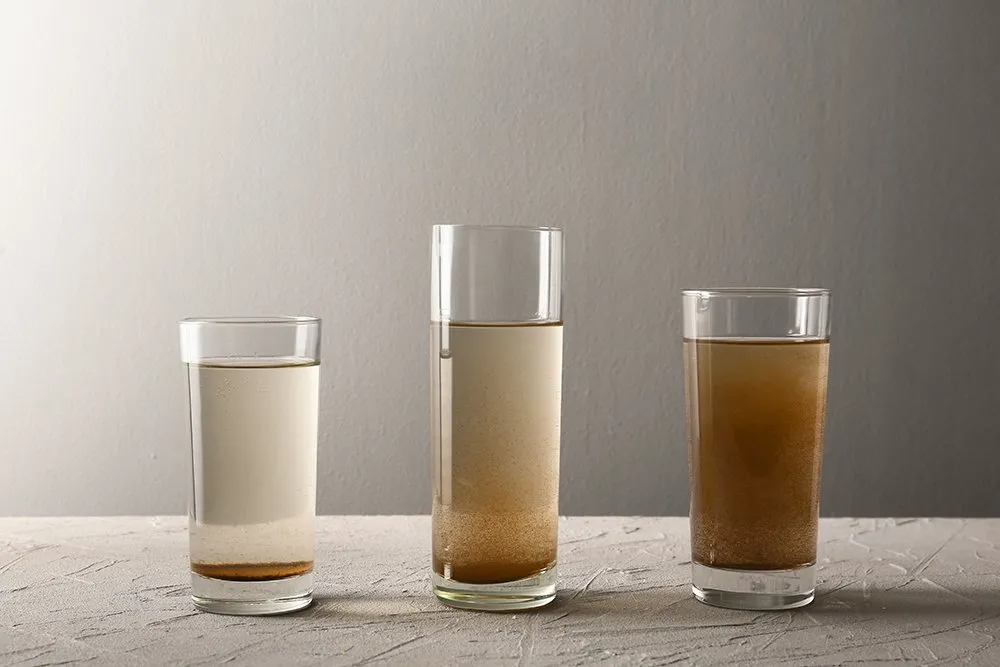Background on Dissolved Iron
SOURCES
Iron is naturally found in the earth’s crust, and dissolved iron found in groundwater that is not exposed to oxygen. Water with ferrous iron is clear and colorless until oxygen is absorbed and reacts with the iron to form non-soluble ferric oxide (iron oxide or “red rust”). The iron in homes may b e from the incoming water supply, or corrosion of steel piping components.
CONCERNS
Based on the EPA, the secondary regulation limit for iron in drinking water is 0.3 mg/L. This number is strictly based on aesthetics (odor and taste) as iron is not considered a health risk. Iron is essential for good health because it helps blood to transport oxygen around the body. The reasoning for the limit on iron is that it stains and contaminates anything it touches leaving a gray, black, red-brown , or yellow-brown stain, and has an unpleasing odor and taste in drinking water. Iron may also promote the growth of iron bacteria (non-disease producing). They grow and multiply in water, then oxidize the iron to insoluble ferric state to make a thick rust colored slime or sludge on fittings or hoses. Organic iron combines with organic matter (tannins) to stain water. This form is usually found in shallow wells and surface water.
REMEDIES
Treatment of iron can include: aeration, filtration, adding chlorine bleach, hydrogen peroxide or ozone, flushing, or cleaning by soaking iron stains in sodium metabisulfite (iron out or rust out).
Background on Hardness
SOURCES
Hard water is high in dissolved minerals, specifically calcium and magnesium. The higher the amount of minerals, the higher the hardness of the water.
CONCERNS
Hardness is not a health risk, it actually contributes a small amount to the total calcium and manganese daily human requirements. It does however cause mineral build-up on fixtures, poor soap and detergent performance. Scale build-up of calcium and manganese may cause clogs in piping, and has been known to increase energy bills by up to 25%.
REMEDIES
Some tips to combat hardness are to choose soaps and detergents to match the hardness of your water; reduce the temperature of your boiler to ~55°C to reduce mineral deposits; and use white vinegar or rinse agents in your dishwasher to remove the film from dishes.
Background on Dissolved Sulfate
SOURCES
Sulfates (SO4) are salts of sulfuric acid (H2SO4). They occur naturally in rain water, or man-made from industrial waste, battery acid, Epsom salts, plaster, some drugs, and algaecides. Many of the sulfate salts are highly soluble in water. Sulfates occur as microscopic particles from fossil fuel burning and can create acid rain. There are two types of bacteria associated with sulfate: sulfate reducing and sulfate oxidizing. Sulfate reducing bacteria live where there is little or no oxygen (such as deep wells, plumbing systems, water softeners, and water heaters), and they convert sulfate and other sulfur compounds to hydrogen sulfide gas (gives off a rotten egg smell). They are usually found in the hot water plumbing. Sulfur oxidizing bacteria convert sulfide to sulfate, making a dark slime that clogs piping, stains clothes, and blackens water (these are less common than the reducing bacteria).
CONCERNS
The Environmental Protection Agency set a secondary drinking water regulation maximum limit for sulfate at 250 mg/L (parts per million). This is because dissolved sulfate has a bitter or medicinal taste, it corrodes copper piping, it can cause extreme hardness, a scale can build up on piping, and it can have a laxative effect (30 grains per gallon or more are consumed when combined with calcium and magnesium).
REMEDIES
Treatment depends upon the form and quantities of sulfate, the amount of iron, manganese, and bacteria, and how much water must be treated. For a small amount of water, distillation and reverse osmosis; and ion exchange for large quantities. The last option is to find an alternative water source such as bottled water, or tapping into the city water system.
For more information checkout the following links
- https://www.water-rightgroup.com/resources/common-water-contaminants-and-risks/
- https://www.pca.state.mn.us/sites/default/files/sulfate7.pdf
- https://www.usgs.gov/special-topic/water-science-school/science/hardness-water?qt-science_center_objects=0#qt-science_center_objects
- https://www.water-rightgroup.com/resources/common-water-contaminants-and-risks/

